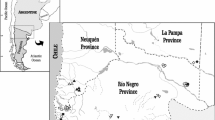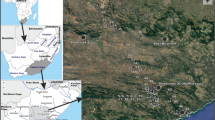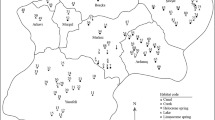Abstract
Ecological and biogeographical studies of Neotropical non-marine ostracods are rare, although such information is needed to develop reliable paleoecological and paleoclimatic reconstructions for the region. An extensive, yet little explored South American area of paleoclimatic interest, is the arid-semiarid ecotone (Arid Diagonal) that separates arid Patagonia from subtropical/tropical northern South America, and lies at the intersection of the Pacific and Atlantic atmospheric circulation systems. This study focused on the Laguna Llancanelo basin, Argentina, a Ramsar site located within the Arid Diagonal, and was designed to build a modern dataset using ostracods (diversity, spatial distribution, seasonality, habitat preferences) and water chemistry. Cluster and multivariate analysis of the data indicated that salinity is the most significant variable segregating two ostracod groups. Limnocythere aff. staplini is the only species that develops abundant populations in the saline ephemeral Laguna Llancanelo during almost all seasons, and is accompanied by scarce Cypridopsis vidua in summer. The latter species is abundant in freshwater lotic sites, where Ilyocypris ramirezi, Herpetocypris helenae, and Cyprididae indet. are also found in large numbers. Darwinula stevensoni, Penthesilenula incae, Heterocypris incongruens, Chlamydotheca arcuata, Chlamydotheca sp., Herpetocypris helenae, and Potamocypris smaragdina prefer freshwater lentic conditions (springs), with C. arcuata and Chlamydotheca sp. found only in the Carapacho warm spring, which has a year-round constant temperature of ~20 °C. Seasonal sampling was necessary because some taxa display a highly seasonal distribution. Species that were recorded have either subtropical or Patagonian affinities, although a few taxa are endemic or common to both regions. These data can serve as modern analogues for reconstructing the late Quaternary history of the area, and to investigate the extent and position of the arid/semiarid ecotone (Arid Diagonal) during past glacial/interglacial cycles.







Similar content being viewed by others
References
Alvarez A, Wetten C (2004) Hidroquímica y sistemas de flujo subterráneo en áreas próximas al humedal de Llancanelo, tenor natural de hidrocarburos, Mendoza, Argentina. XXXIII Congreso Internacional AIH, 7º ALHSUD, Zacatecas, Actas 32–33
Ballent SC, Díaz AR (2011) Contribution to the taxonomy, distribution and paleoecology of the early representatives of Penthesilenula Rossetti & Martens, 1998 (Crustacea, Ostracoda, Darwinulidae) from Argentina, with the description of a new species. Hydrobiologia 688:125–138. doi:10.1007/s10750-011-0658-8
Bruniard ED (1982) La diagonal árida argentina: un límite climático real. Rev Geogr 95:5–20
Chivas AR, De Deckker P, Shelley JMG (1983) Magnesium, strontium and barium partitioning in non-marine ostracode shells and their use in paleoenvironmental reconstructions—a preliminary study. In: Maddocks RF (ed) Applications of Ostracoda. University of Houston Geoscience, Houston, pp 238–249
Chivas AR, De Deckker P, Shelley JMG (1985) Strontium content of ostracods indicates lacustrine palaeosalinity. Nature 316:251–253. doi:10.1038/316251a0
Chivas AR, De Deckker P, Shelley JMG (1986a) Magnesium and strontium in non-marine ostracod shells as indicators of palaeosalinity and palaeotemperature. Hydrobiologia 143:135–142. doi:10.1007/bf00026656
Chivas AR, De Deckker P, Shelley JMG (1986b) Magnesium content of non-marine ostracode shells: a new palaeosalinometer and palaeothermometer. Palaeogeogr Palaeoclimatol Palaeoecol 54:43–61. doi:10.1016/0031-0182(86)90117-3
Ciocco NF, Scheibler EE (2008) Malacofauna of the littoral benthos of a saline lake in southern Mendoza, Argentina. Fundam Appl Limnol 172:87–98. doi:10.1127/1863-9135/2008/0172-0087
Curry BB (1999) An environmental tolerance index for ostracodes as indicators of physical and chemical factors in aquatic habitats. Palaeogeogr Palaeoclimatol Palaeoecol 148:51–63. doi:10.1016/s0031-0182(98)00175-8
Curry BB, Delorme LD, Smith AJ, Palmer DF, Stiff BJ (2012) The biogeography and physicochemical characteristic of aquatic habitats of freshwater ostracods in Canada and United States. In: van der Meer JJM (ed) Ostracoda as proxies for Quaternary climate change, vol 17. Developments in Quaternary science series. Elsevier, Amsterdam, pp 85–116
Cusminsky GC, Pérez PA, Schwalb A, Whatley R (2005) Recent lacustrine ostracods from Patagonia, Argentina. Rev Esp Micropaleontol 37:431–450
Cusminsky GC, Martínez D, Bernasconi E (2006) Foraminíferos y ostrácodos de sedimentos recientes del estuario de Bahía Blanca, Argentina. Rev Esp Micropaleontol 38:395–410
Cusminsky GC, Schwalb A, Pérez PA, Pineda D, Viehberg F, Whatley RC, Markgraf V, Gilli A, Ariztegui D, Anselmetti FS (2011) Late Quaternary environmental changes in Patagonia as inferred from lacustrine fossil and extant ostracods. Biol J Linnean Soc 103:397–408. doi:10.1111/j.1095-8312.2011.01650.x
D’Ambrosio DS, Díaz AR, García A, Claps MC (2015) First description of the soft part anatomy of Ilyocypris ramirezi Cusminsky & Whatley (Crustacea, Ostracoda) from Argentina, South America. Zootaxa 3957:059–068. doi:10.11646/zootaxa.3957.1.4
D’Ambrosio DS, Claps MC, García A (2016a) Zooplankton of a protected and vulnerable wetland system in southern South America (Llancanelo área, Argentina). Int Aquat Res 8:65–80. doi:10.1007/s40071-016-0125-2
D’Ambrosio DS, Díaz AR, García A, Claps MC (2016b) First record and revised description of Herpetocypris helenae G. W. Müller, 1908 (Crustacea, Ostracoda) from the Neotropics (central-west Argentina). Spixiana 39:29–38
De Deckker P, Forester RM (1988) The use of ostracods to reconstruct continental palaeoenvironmental records. In: De Deckker P, Colin JP, Peypouquet JP (eds) Ostracoda in the earth sciences. Elsevier, New York, pp 175–199
De Francesco CG (2010) Moluscos y paleoambientes del centro-oeste de Argentina durante el Cuaternario. In: Zarate M, Gil A, Neme G (eds) Condiciones paleoambientales y ocupaciones humanas durante la transición Pleistoceno-Holoceno y Holoceno de Mendoza. Publicaciones de la Sociedad Argentina de Antropología, Buenos Aires, pp 151–174
De Francesco CG, Hassan GS (2009) The significance of molluscs as paleoecological indicators of freshwater systems in central-western Argentina. Palaeogeogr Palaeoclimatol Palaeoecol 274:105–113. doi:10.1016/j.palaeo.2009.01.003
Delorme LD (1971) Freshwater ostracodes of Canada. Part V. Families Limnocytheridae, Loxoconchidae. Can J Zool 49:43–64
Díaz AR, Lopretto EC (2011) The genus Chlamydotheca Saussure (Crustacea: Ostracoda) in northeastern Argentina. Nauplius 19:97–107. doi:10.1590/s0104-64972011000200001
Forester RM (1983) Relationship of two lacustrine ostracode species to solute composition and salinity: implication for paleohydrochemistry. Geology 11:435–438
Forester RM, Smith AJ, Palmer DF, Curry BB (2005) North American ostracode database “NANODe” version 1. http://www.kent.edu/NANODe/. Accessed 22 May 2016
García A (1999) Quaternary charophytes from Salina del Bebedero, Argentina: their relation with extant taxa and paleolimnological significance. J Paleolimnol 21:307–323. doi:10.1023/A:1008067112334
Gouramanis C, Wilkins D, De Deckker P (2010) 6000 years of environmental changes recorded in Blue Lake, South Australia, based on ostracod ecology and valve chemistry. Palaeogeogr Palaeoclimatol Palaeoecol 297:223–237. doi:10.1016/j.palaeo.2010.08.005
Grimm E (2004) Tilia software. Research and Collections Center, Illinois State Museum, Springfield
Gutentag ED, Benson RH (1962) Neogene (Plio–Pleistocene) fresh-water ostracodes from the central high plains. Bull State Geol Surv Kansas 157:1–60
Hammer UT, Shamess J, Haynes RC (1983) The distribution and abundance of algae in saline lakes of Saskatchewan, Canada. Hydrobiologia 105:1–26. doi:10.1007/bf00025173
Horne DJ, Curry BB, Delorme LD, Martens K, Smith AJ, Smith RJ (2011) OMEGA: the ostracod metadatabase of environmental and geographical attributes. Joannea Geol Paläont 11:80–84
Isla FI, Ruiz Barlett E, Márquez J, Urrutia A (2005) ENSO signal recognized by NDVI images from Llancanelo shallow lake, Mendoza, Argentina. XVI Congreso Geológico Argentino, La Plata, Actas 4, pp 333–338
Külköylüoĝlu O (2003) Ecology of freshwater Ostracoda (Crustacea) from lakes and reservoirs in Bolu, Turkey. J Freshw Ecol 18:343–347. doi:10.1080/02705060.2003.9663968
Laprida C (2006) Ostrácodos recientes de la llanura pampeana, Buenos Aires, Argentina: ecología e implicancias paleolimnológicas. Ameghiniana 43:181–204
Laprida C, Díaz A, Ratto N (2006) Ostracods (Crustacea) from thermal waters, southern Altiplano, Argentina. Micropaleontol 52:177–188. doi:10.2113/gsmicropal.52.2.177
Liberto R, Mesquita-Joanes F, César I (2012) Dynamics of pleustonic ostracod populations in small ponds on the Island of Martín García (Río de la Plata, Argentina). Hydrobiologia 688:47–61. doi:10.1007/s10750-011-0600-0
Markgraf V, Bradbury JP, Schwalb A, Burns SJ, Stern C, Ariztegui D, Gilli A, Anselmetti FS, Stine S, Maidana N (2003) Holocene palaeoclimates of southern Patagonia: limnological and environmental history of Lago Cardiel, Argentina. Holocene 13:581–591. doi:10.1191/0959683603hl648rp
Martens K, Schon I, Meisch C, Horne DJ (2008) Global biodiversity of non-marine Ostracoda (Crustacea). In: Balian EV, Lévȇque C, Segers H, Martens K (eds) Freshwater animal diversity assessment. Hydrobiologia 599:185–193
Meisch C (2000) Freshwater Ostracoda of Western and Central Europe. In: Schwoerbel J, Zwick P (eds) Süsswasserfauna von Mitteleuropa 8/3. Spektrum Akademischer Verlag, Heidelberg, p 522
Mourguiart P, Corrège T, Wirrmann D, Argollo J, Montenegro ME, Pourchet M, Carbonel P (1998) Holocene palaeohydrology of Lake Titicaca estimated from an ostracod-based transfer function. Palaeogeogr Palaeoclimatol Palaeoecol 143:51–72. doi:10.1016/s0031-0182(98)00068-6
Ostera HA, Dapeña C (2003) Environmental isotopes and geochemistry of bañado Carilauquen, Mendoza, Argentina. In: IV South American symposium on isotope geology, Actas 461–464
Palacios-Fest MR, Cusminsky GC, McGlue MM (2016) Late Quaternary lacustrine ostracods (Ostracoda, Crustacea) and charophytes (Charophyta, Charales) from the Puna Plateau, Argentina. J Micropalaeontol 35:66–78
Peralta P, Fuentes V (2005) Fitobentos, fitoplancton y zooplancton litoral del bañado de Carilauquen, Cuenca de Llancanelo, Mendoza, Argentina. Limnetica 24:183–198
Pielou EC (1984) The interpretation of ecological data. Wiley, New York
Piovano EL, Ariztegui D, Córdoba F, Cioccale M, Sylvestre F (2009) Hydrological variability in South America below the Tropic of Capricorn (Pampas and Patagonia, Argentina) during the last 13.0 ka. In: Vimeux F, Sylvestre F, Khodri M (eds) Past climate variability in South America and surrounding regions, Developments in paleoenvironmental research, vol 14. Springer, Berlin, pp 323–351. doi:10.1007/978-90-481-2672-9-14
Ramón Mercau J, Laprida C, Massaferro J, Rogora M, Tartari G, Maidana NI (2012) Patagonian ostracods as indicators of climate related hydrological variables: implications for paleoenvironmental reconstructions in southern South America. Hydrobiologia 694:235–251. doi:10.1007/s10750-012-1192-z
Ramón Mercau J, Plastani MS, Laprida C (2014) A review of the genus Limnocythere (Podocopida: Limnocytheridae) in the Pampean region (Argentina), with the description of a new species, Limnocythere cusminskyae sp. nov. Zootaxa 3821:026–036. doi:10.11646/zootaxa.3821.1.2
Ramos VA, Folguera A (2011) Payenia volcanic province in the Southern Andes: an appraisal of an exceptional Quaternary tectonic setting. J Volcanol Geotherm Res 201:53–64. doi:10.1016/j.jvolgeores.2010.09.008
Scheibler EE, Ciocco NF (2011) Distribution of macroinvertebrate assemblages along a saline wetland in harsh environmental conditions from Central-West Argentina. Limnologica 41:37–47. doi:10.1016/j.limno.2010.03.001
Scheibler EE, Ciocco NF (2013) Diversity of aquatic insects and other associated macroinvertebrates in an arid wetland (Mendoza Province, Argentina). Rev Soc Entomol Argent 72:41–53
Schwalb A, Burns SJ, Cusminsky G, Kelts K, Margraff V (2002) Assemblage diversity and isotopic signals of modern ostracods and host waters from Patagonia, Argentina. Palaeogeogr Palaeoclimatol Palaeoecol 187:323–339. doi:10.1016/s0031-0182(02)00484-4
ter Braak CJF (1986) Canonical correspondence analysis: a new eigenvector technique for multivariate direct gradient analysis. Ecology 67:1167–1179. doi:10.2307/1938672
ter Braak CJF, Smilauer P (2002) CANOCO reference manual and CanocoDraw for Windows user’s guide: software for canonical community ordination (version 4.5). Microcomputer Power, Ithaca
ter Braak CJF, Verdonschot PFM (1995) Canonical correspondence analysis and related multivariate methods in aquatic ecology. Aquat Sci 57:255–289. doi:10.1007/BF00877430
Acknowledgements
We thank the Dirección de Recursos Naturales de la Provincia de Mendoza for facilitating the research on this Ramsar site. We also thank park ranger Fabricio Ayala for his invaluable help in the field. We thank Silvina Lassa, Nick Mackie and Rafael Urréjola for technical assistance with the SEM. The assistance of David Wheeler and Lili Yu at the University of Wollongong is greatly appreciated. This work was supported by a grant from the Agencia Nacional de Promoción Científica y Tecnológica, FONCYT (Argentina) (Grant Raíces 2006 – PICT 1311), which also enabled DSD to take a visiting position in Wollongong.
Author information
Authors and Affiliations
Corresponding author
Electronic supplementary material
Below is the link to the electronic supplementary material.
Rights and permissions
About this article
Cite this article
D’Ambrosio, D.S., García, A., Díaz, A.R. et al. Distribution of ostracods in west-central Argentina related to host-water chemistry and climate: implications for paleolimnology. J Paleolimnol 58, 101–117 (2017). https://doi.org/10.1007/s10933-017-9963-1
Received:
Accepted:
Published:
Issue Date:
DOI: https://doi.org/10.1007/s10933-017-9963-1




